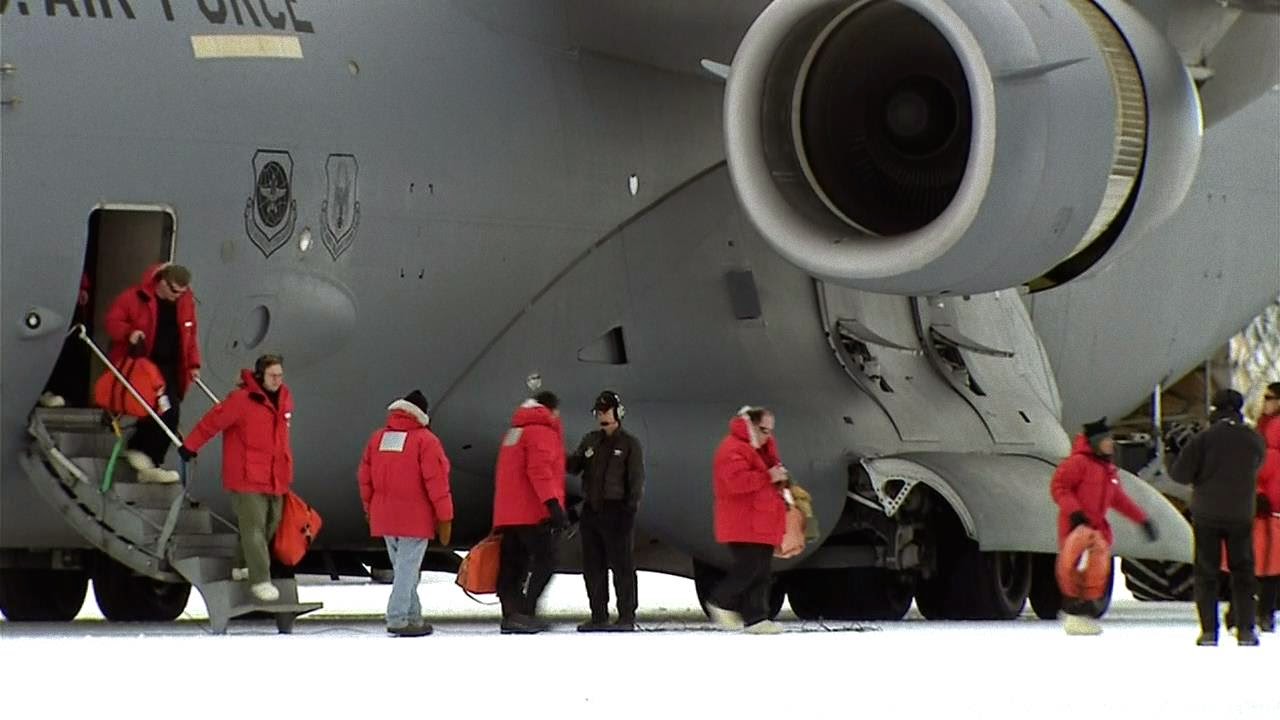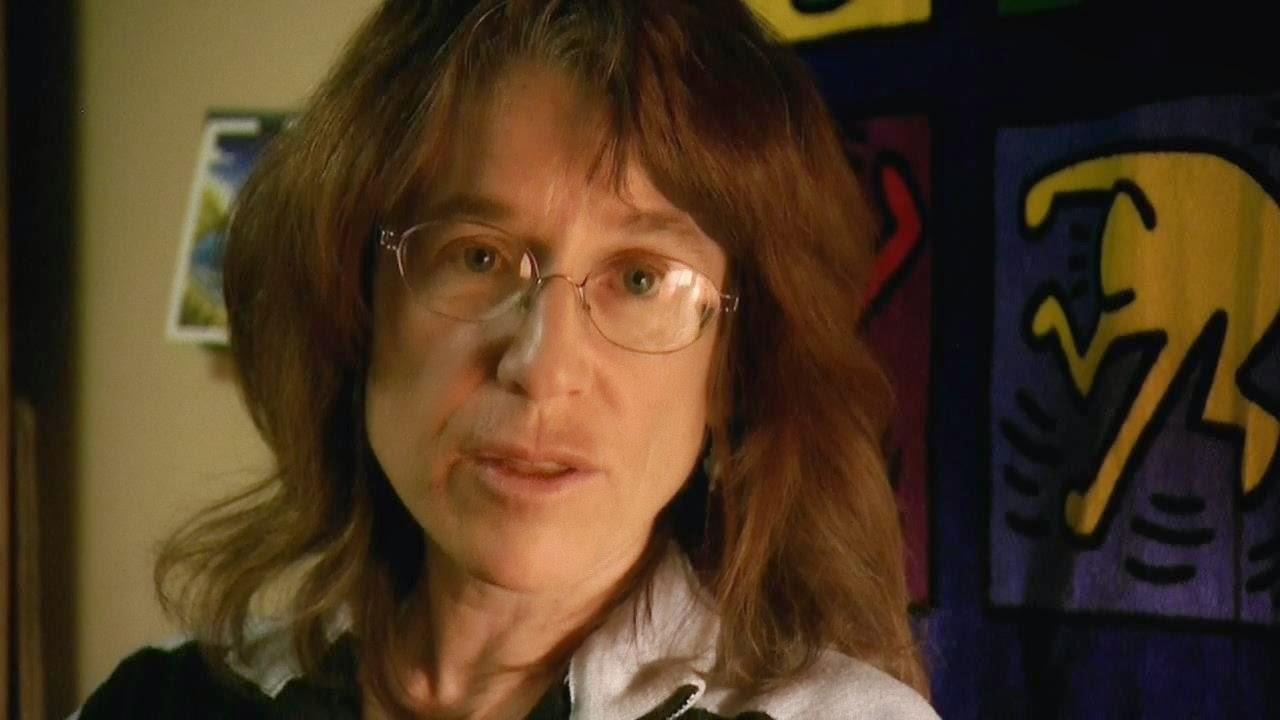 |
| Military Jet. |
Werner Herzog's Antarctica masterpiece permits no sass, no juvenile observation, no insincerity, and no indifference. His film asserts awe out of the viewer, even if it's the awe of how numbed they are by the sheer magnificence of ice, snow, and particularly sharp human souls breathing wisdom into the unforgiving chill of the air that envelops them. This is a film of absolutes. There is no grey, no ambiguity: this film descends on the viewer with truthful observations like an avalanche. When you enter this world you will realize some clusters of ice have thawed around your soul and your mind, but you have to watch it again because the thawing process left glaciers in its wake. Yet, I came away with observations and took some notes.
 |
| Men outside landed miltary jet. |
 |
| Big red bus. |
Herzog and many others arrive by military jet from New Zealand. He is impressed by big red "buses" and the mining camp characteristics of McMurdo Station. First, we meet Stefan Pashov, philosopher and forklift driver. This man's soul is poetry, one quote he shares: "The universe dreams through our dreams." During the subsequent voice-over, Werner Herzog refers to the people who have descended upon Antarctica as "professional dreamers." These are absolute truths, there is no denying the relentless presence of dreams and their powers to push us in all manner of direction, sometimes they drive us to extreme isolation, sometimes both.
 |
| Stefan Pashov. |
McMurdo Station has many creature comforts; Herzog labels these as "abominations," such as a bowling alley, an aerobics studio, and yoga classes.
 |
| Douglas MacAyeal. |
A glaciologist, Douglas MacAyeal offers yet another turn of phrase: "I am adrift in the ocean, a vagabond floating in the ocean, and below my feet, I can feel the rumble of the iceberg. I can feel the change, the cry of the iceberg as it's screeching and as it's bouncing off the sea bed. As it's steering the ocean's currents, as it's being moved north, I can feel that sound coming up through the bottoms of my feet and telling me that this iceberg is coming north. That's my dream." And then he offers up his glacial activity insights.
 |
| Bucket Head Whiteout simulation. |
 |
| Sheer horror of the sea discussion. |
 |
| Weddell seal. |
We witness a distinctive training exercise where scientists must wear buckets to simulate whiteout conditions, since buckets cut off vision and most sound. This is referred to as the bucket head exercise. What's peculiar is that these buckets are painted with faces, which serve no immediately practical purpose.
Physiologist Regina Eisert speaks about the unusual, strange frequency swooshing sounds that Weddell seals make and the possibilities of their milk for human weight loss.
Sheer terrors that lurk in the icy depth are also covered, creatures with tendrils and mandibles, and blob-like creatures are discussed with great dread. It's suggested that mammals arose to get away from these creatures. Sometimes things are just a little different. For instance, a sea urchin has a scarlet parasitic worm that lives in the anus.
 |
| Diving footage. |
 |
| Diving footage. |
We see divers dive waters that are -2 degrees Celsius. Herzog observes that the divers do not speak as they prepare for the dive. He offers: "They were like preachers preparing for mass." And these diving sequences are more visually stunning that the 1980's IMAX documentary, we get to see far more crevices and colossal scale in this one.
The music by Henry Kaiser And David Lindley creates a sacred space for these images to unfold and for our souls to unwind. Encompassing world music, choral, and electronics, the score manages to convey everything it needs to.
We learn about the alarming death rates of languages, those of small civilizations.
We hear accounts from Karen Joyce, traveler and computer expert, who once rode in a section of sewer pipe on the back of a truck during a hitchhiking excursion from Denver, Colorado to Bolivia. She also went from London to Nairobi in a garbage truck. She has tons of far out tales.
 |
| Karen Joyce |
Herzog presses for insights about the sexuality of penguins. Turns out, sometimes penguins have triangular sexual relationships. Sometimes they have gender identity issues. To get rocks for nesting, penguins will engage in a sort of prostitution.
 |
| Seal has split from the group and runs toward certain death. |
Mt. Erebus, the second highest volcano in Antarctica, is studied on camera. More colorful characters occupy the scientific team at the lava lake. The camera focuses on their iced over facial hair. On the slopes, steam causes fumaroles, chimneys of ice that reach about two stories high, to form.
 |
| Mt. Erebus Volcano |
There's also the Neutrino Project, which involved sending a massive helium balloon (rigged to measure its environment) up to the stratosphere. "Neutrinos
are subatomic particles produced by the decay of radioactive elements and are elementary particles that lack an electric charge" (
Source). Apparently, as I expected, much more is known about these since the documentary was made because the scientist in the film gives a much more mystical and mystified description of what they are.
Doomsday is coming for our species. That is a defining sentiment. The scientists agree that it's only a matter of time before nature eradicates us. It doesn't get any more absolute than that.
 |
| Neutrino Project Physicist |
I've seen three Antarctica documentaries to date: this one,
Antarctica (IMAX), and
Australian Geographic: A Year on Ice.
Australian Geographic: A Year On Ice is about the very gritty, claustrophobic reality of traveling to and from Antarctica by boat and living there in a low-tech hut for an entire year. The other two films are about bigger expeditions with major facilities such that the people can actually spread their arms. However, the IMAX production is rather superficial and much more dated (although that's good as much as it's a shortcoming).
Ultimately,
Encounters at the End of the World is the most information-rich and emotion-rich, and it is every bit as beautiful as the IMAX film. A majo

















No comments:
Post a Comment